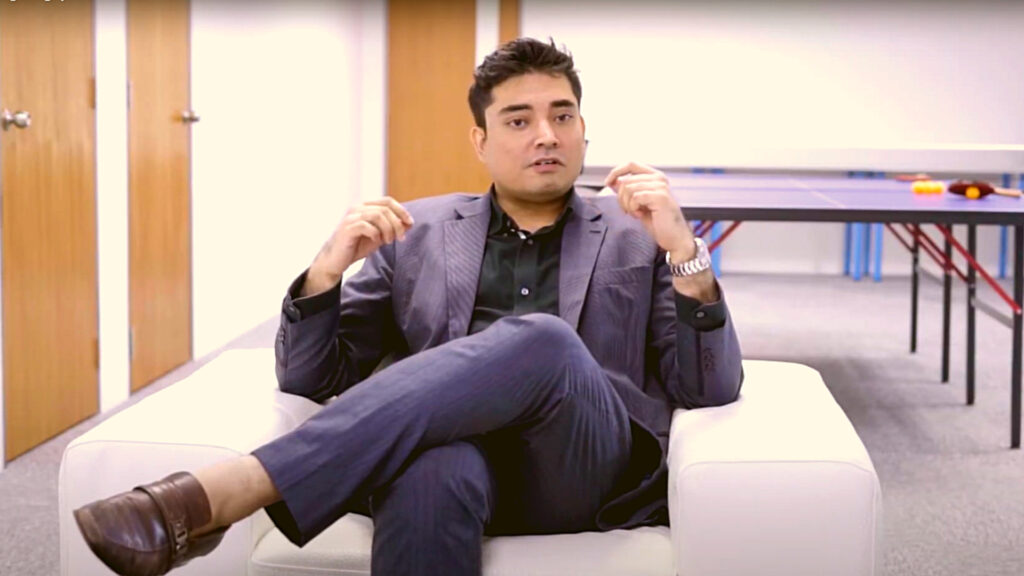It’s not often you meet someone who can memorize a 160-digit number in under five minutes or recall a deck of cards in the same time it takes most of us to tie our shoes. But that’s precisely the talent of Sancy Suraj, a memory athlete, and motivational speaker. His prowess in memory retention and recall has earned him multiple records in the Singapore Book of Records and even a Guinness World Record. But Suraj’s work goes beyond breaking records; he uses his talents to inspire and motivate others.

How do memory and motivation intersect in your work as an inspirational speaker, and why are they important for personal growth?
As an inspirational speaker, I believe that memory and motivation are two key components that intersect in a powerful way to promote personal growth. Memory is essential for retaining information and knowledge, while motivation is the driving force that propels individuals to take action and achieve their goals. When these two elements are combined, individuals can tap into their full potential and accomplish remarkable feats.
Memory plays a crucial role in my work as an inspirational speaker because it enables me to impart information in a way that is easily retained and recalled by my audience. I use memory techniques to help individuals remember important concepts and ideas, and to make my presentations more engaging and memorable. By improving their memory skills, individuals can also enhance their ability to learn and retain new information, which is essential for personal growth and development.
Motivation is equally important in my work as an inspirational speaker. I believe that motivation is the driving force that enables individuals to overcome obstacles, push beyond their limits, and achieve their goals. By inspiring and motivating individuals, I help them tap into their inner strength and unleash their full potential. I use a range of techniques to motivate individuals, including storytelling, humor, and personal anecdotes. By tapping into the emotions of my audience, I am able to create a powerful connection that motivates them to take action and achieve their goals.
Overall, the intersection of memory and motivation is a powerful force that promotes personal growth and development. By improving their memory skills and harnessing their motivation, individuals can achieve remarkable feats and reach their full potential. As an inspirational speaker, I am committed to helping individuals tap into this power and unlock their inner greatness.
Can you share some specific memory techniques that people can use to improve their retention and recall of important information?
Absolutely. As a memory athlete and trainer, I have developed a range of memory techniques that can help individuals improve their retention and recall of important information. Here are a few techniques that I often recommend to my clients:
- The Memory Palace Technique: This is a powerful technique that involves visualizing a familiar location, such as your home or workplace, and mentally placing items that you want to remember in specific locations within that space. By associating each item with a specific location, you can easily recall the information when you mentally walk through the space.
- The Linking Method: This technique involves creating associations between items that you want to remember, using vivid mental images. For example, if you want to remember a shopping list that includes apples, milk, and bread, you might create an image of a cow jumping over an apple tree, while holding a loaf of bread in its mouth. By linking the items in this way, you can recall them more easily.
- The Story Method: This technique involves creating a story that incorporates the information that you want to remember. By weaving the information into a narrative, you can make it more memorable and easier to recall.
- Mnemonic Devices: These are memory aids that use patterns, acronyms, or other techniques to help you remember information. For example, you might use the acronym “ROYGBIV” to remember the colors of the rainbow (red, orange, yellow, green, blue, indigo, and violet).
By using these and other memory techniques, individuals can improve their retention and recall of important information, which can be especially useful in academic, professional, and personal contexts. With practice and dedication, anyone can develop their memory skills and unlock their full potential.
How do you use storytelling and visualization to motivate your audience and help them remember key messages?
Storytelling and visualization are powerful tools that I use in my work as an inspirational speaker to motivate my audience and help them remember key messages. I believe that people are naturally drawn to stories, and that by weaving stories into my presentations, I can create a deeper connection with my audience and inspire them to take action.
When I tell stories, I aim to make them relatable and relevant to my audience’s experiences. By sharing personal anecdotes and examples that resonate with them, I can help my audience see how the key messages I am conveying apply to their own lives. I also use stories to create emotional connections with my audience, tapping into their hopes, fears, and aspirations. By making my audience feel emotionally invested in the stories I am telling, I can inspire them to take action and make positive changes in their lives.
Visualization is another powerful technique that I use to help my audience remember key messages. I often use visual aids, such as images and diagrams, to help my audience visualize key concepts and ideas. I also encourage my audience to visualize themselves achieving their goals and living the life they want to lead. By helping them see themselves succeeding, I can inspire them to take action and make their vision a reality.
Ultimately, storytelling and visualization are powerful tools that can help individuals connect with their goals, stay motivated, and remember important messages. By harnessing the power of these techniques, I am able to create a memorable and impactful experience for my audience, inspiring them to take action and achieve their full potential.
“Through the art of storytelling and the power of visualization, we can inspire others to see their dreams as possibilities and turn them into realities.”
What are some common barriers to motivation, and how do you help your audience overcome them?
As an inspirational speaker, I have encountered many common barriers to motivation in my work with clients and audiences. Some of the most common barriers include fear of failure, lack of self-confidence, and feeling overwhelmed by the size of a task or goal.
To help my audience overcome these barriers, I first work to create a safe and supportive environment where individuals feel comfortable sharing their fears and concerns. I then help them develop strategies to address these barriers and build their self-confidence.
For example, if someone is afraid of failing, I encourage them to reframe their mindset around failure. Rather than seeing failure as a negative outcome, I help them see it as an opportunity for growth and learning. By shifting their perspective on failure, individuals can become more resilient and better equipped to handle setbacks and challenges.
If someone lacks self-confidence, I help them identify their strengths and accomplishments, and encourage them to celebrate these achievements. I also work with them to develop a growth mindset, emphasizing that their abilities can improve with practice and dedication.
Finally, if someone feels overwhelmed by the size of a task or goal, I help them break it down into smaller, more manageable steps. By taking small, consistent actions towards their goal, individuals can build momentum and gain confidence in their ability to achieve success.
Ultimately, my goal as an inspirational speaker is to help individuals overcome their barriers to motivation, and develop the mindset and skills they need to achieve their full potential.
How do you tailor your talks to different types of learners (e.g. visual, auditory, kinesthetic)?
As an inspirational speaker, I believe it is important to tailor my talks to different types of learners, including visual, auditory, and kinesthetic learners. I recognize that everyone learns differently, and by catering to their individual learning styles, I can ensure that my message is received and understood by as many people as possible.
For visual learners, I incorporate visual aids such as slides, diagrams, and images into my presentations. I use color and design to emphasize key points and help them visualize complex ideas. I also incorporate stories and real-life examples to help them connect with the material on a more emotional level.
For auditory learners, I use spoken language as my primary mode of communication. I use storytelling, humor, and pacing to keep them engaged and interested. I also incorporate interactive elements such as questions and group discussion to keep them actively involved in the learning process.
For kinesthetic learners, I incorporate physical activities and demonstrations into my presentations. I may ask them to stand up and move around, or use props and hands-on activities to help them understand key concepts. I also encourage them to take notes, write down their thoughts, and actively participate in group discussions to help them process the information.
In addition to these approaches, I also use a variety of teaching methods to appeal to different learning styles. For example, I may use role-playing exercises or group activities to appeal to kinesthetic learners, while also incorporating visual aids and storytelling to appeal to visual and auditory learners.
Ultimately, my goal is to create an engaging and effective learning experience for all types of learners, so that everyone can benefit from my message and be inspired to take action.
“By understanding and catering to different learning styles, we can create a more inclusive and effective learning environment, and inspire individuals to unlock their full potential.”
In an interview with us, Suraj shares how he integrates memory and motivation in his work as an inspirational speaker. He delves into the specific memory techniques he uses to help people improve their retention and recall of important information. Suraj emphasizes the importance of storytelling and visualization in his talks, which he uses to motivate his audience and help them remember key messages.
Suraj tailors his talks to different types of learners and works to debunk common misconceptions about memory and motivation. He provides practical tips for maintaining a healthy mind-body connection, something that he believes is essential for overall wellbeing. Through his work, Suraj has developed his own memory and motivation skills, which he shares with his audience to help them achieve personal growth and reach their goals.

Can you share a story or example of how memory techniques have helped you in your personal or professional life?
Certainly, as someone who has spent many years studying and teaching memory techniques, I have had countless experiences where these methods have helped me in both my personal and professional life.
One example that stands out to me is when I was studying for my Guinness World Record attempt for the longest color sequence memorized. In order to achieve this feat, I had to memorize over 160 colors in the correct sequence. To do this, I used a technique called the memory palace, which involves mentally placing each color in a specific location in a familiar setting, such as a house or building. By visualizing each color in its assigned location, I was able to recall the entire sequence in order.
Not only did this technique help me achieve the world record, but it has also helped me in my professional life as a memory trainer and keynote speaker. I have used this technique to help clients and audiences remember complex information, such as speeches, presentations, and even entire books.
Another example of how memory techniques have helped me personally is in my daily life. Like many people, I often forget important details such as names, faces, and appointments. However, by using techniques such as visualization, association, and repetition, I have been able to improve my memory and recall of these details. For example, if I meet someone new, I may associate their name with a visual image or story, which helps me remember it later on.
Overall, memory techniques have been a valuable tool in both my personal and professional life. They have allowed me to achieve feats such as world records, and have helped me to become a more effective communicator and memory trainer. I am grateful for the opportunity to share these techniques with others and help them achieve their own memory-related goals.
How do you balance the need for goal-setting with the importance of enjoying the present moment?
Goal-setting and living in the present moment are both important aspects of personal growth, and I believe that finding a balance between the two is key. As someone who is passionate about memory training and motivation, I often find myself setting ambitious goals for myself and my clients. However, I also recognize the importance of being present and enjoying the journey, rather than just focusing on the end result.
One way that I balance goal-setting and enjoying the present moment is by setting process-oriented goals rather than outcome-oriented goals. For example, instead of setting a goal to win a memory competition, I may set a goal to practice a certain number of hours each day, or to master a new memory technique. By focusing on the process of improving, I am able to enjoy the daily practice and learning, rather than just fixating on the end result.
Another way that I balance goal-setting and living in the present moment is by taking time to reflect and celebrate my progress along the way. When I achieve a goal or milestone, I take time to acknowledge and appreciate the hard work and effort that went into it. This helps me stay motivated and engaged in the process, rather than feeling overwhelmed or burnt out.
Ultimately, I believe that the key to balancing goal-setting and enjoying the present moment is to have a growth mindset. By viewing challenges and setbacks as opportunities for learning and growth, we can stay engaged and motivated in the present moment, while still working towards our long-term goals. I encourage my clients and audiences to embrace this mindset and to enjoy the process of personal growth, rather than just focusing on the end result.
What are some common misconceptions about memory and motivation, and how do you debunk them in your talks?
There are several common misconceptions about memory and motivation that I often encounter in my work as an inspirational speaker and memory trainer. One common misconception is that memory is solely based on genetics and cannot be improved through training and practice. In my talks, I debunk this myth by sharing my personal story of how I went from having an average memory to setting Guinness World Records in memorization through training and practice. I also teach specific memory techniques that can be used by anyone to improve their memory and retention of important information.
Another misconception is that motivation is purely an internal factor and cannot be influenced by external factors or environmental conditions. In my talks, I debunk this myth by emphasizing the importance of creating an environment that supports motivation and goal-setting. I share strategies for setting achievable goals, breaking them down into manageable steps, and creating a support system to stay motivated and accountable.
A third misconception is that memory and motivation are unrelated and do not impact each other. In my talks, I emphasize the strong connection between memory and motivation, and how using memory techniques can actually increase motivation by making learning more efficient and enjoyable. I also teach visualization techniques that can be used to increase motivation and create a clear mental image of achieving a desired outcome.
Ultimately, my goal in debunking these misconceptions is to inspire my audiences to believe in their own potential for growth and to take action towards achieving their goals. By providing concrete strategies for improving memory and motivation, I hope to empower individuals to take control of their own personal and professional development.
How has your work as an inspirational speaker helped you develop your own memory and motivation skills?
My work as an inspirational speaker and memory trainer has had a profound impact on my own memory and motivation skills. As I have traveled around the world teaching memory techniques and sharing my story, I have had the opportunity to continually refine and improve my own memory skills. I am constantly challenging myself to memorize longer and more complex sequences of information, and I find that this practice not only keeps my own memory sharp, but also helps me to better understand and communicate the benefits of these techniques to others.
In addition to improving my memory skills, my work as an inspirational speaker has also helped me to stay motivated and focused on my goals. When I am on stage, I am filled with a sense of purpose and passion for my work, and this energy carries over into my personal and professional life. By sharing my story and helping others to develop their own memory and motivation skills, I feel a deep sense of fulfillment and satisfaction.
Another way that my work has helped me to develop my own memory and motivation skills is by exposing me to a wide range of individuals and ideas. As I travel and meet new people, I am constantly inspired by their stories and experiences. This exposure to different perspectives and cultures has broadened my horizons and helped me to stay open-minded and curious about the world around me.
Overall, my work as an inspirational speaker and memory trainer has been a source of great personal and professional growth for me. It has allowed me to continually push the boundaries of what I thought was possible for my own memory and motivation skills, and has given me the opportunity to make a positive impact in the lives of thousands of individuals around the world.
Can you share some tips for maintaining a healthy and balanced mind-body connection?
Maintaining a healthy and balanced mind-body connection is crucial for overall well-being and success. As someone who places great importance on both mental and physical health, I have developed a number of tips and techniques for achieving this balance.
One of the most important things for maintaining a healthy mind-body connection is to prioritize regular exercise and physical activity. This not only helps to keep your body in shape, but also has numerous mental health benefits, such as reducing stress and boosting mood. Whether it’s going for a run, taking a yoga class, or simply taking a walk outside, finding an activity that you enjoy and incorporating it into your routine is key.
Another important aspect of maintaining a healthy mind-body connection is to practice mindfulness and stress reduction techniques. This can include meditation, deep breathing exercises, or simply taking a few moments each day to be present and focus on the moment. By quieting the mind and focusing on the present, you can reduce stress and anxiety, and improve your overall sense of well-being.
In addition to exercise and mindfulness practices, it’s also important to prioritize rest and relaxation. This can mean getting enough sleep each night, taking regular breaks throughout the day, or simply carving out time for activities that you enjoy and that help you to unwind.
By giving yourself the time and space to rest and recharge, you can better manage stress and maintain a healthy mind-body connection.
Overall, maintaining a healthy mind-body connection requires a holistic approach that incorporates physical activity, mindfulness practices, and rest and relaxation. By prioritizing these aspects of your life, you can achieve greater overall well-being and success.
“True success is not just about achieving your goals, but also about maintaining a healthy mind-body connection along the way. Prioritizing exercise, mindfulness, and rest is the key to achieving a balanced and fulfilling life.”
It’s evident that Suraj’s talents and expertise have allowed him to make an impact in the world of memory and motivation. His ability to use memory techniques to help others improve their retention and recall of important information is remarkable. Suraj’s focus on storytelling and visualization as tools for motivating and inspiring audiences sets him apart from other inspirational speakers. Suraj’s work has inspired thousands worldwide, and we look forward to seeing what new records he’ll break in the future.

















